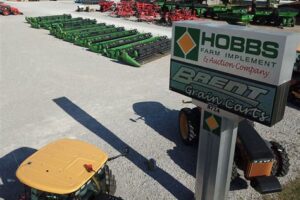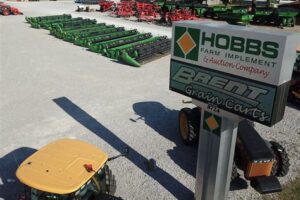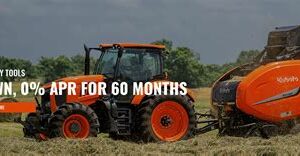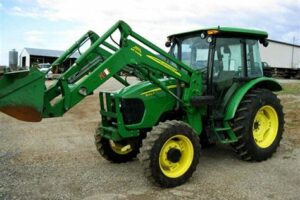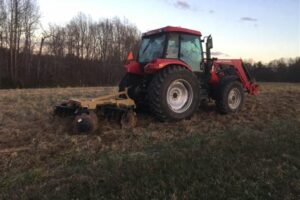Table of Contents
Discover the diverse range of farming equipment used in modern agriculture. From tractors and harvesters to irrigation systems and milking machines, explore the various types of machinery that revolutionize farming practices. Learn how these tools enhance efficiency, productivity, and sustainability in the agricultural industry.
In the world of agriculture, having the right equipment can make all the difference. From ancient times to modern-day farming, various types of equipment have revolutionized the way we cultivate and harvest crops. Whether it’s tractors plowing through fields or drones monitoring crop health from above, the advancements in farming equipment have not only increased productivity but also reduced manual labor. In this article, we will explore different types of farming equipment that have become indispensable for efficient and profitable farming operations.
Introduction
In the world of agriculture, farmers rely heavily on various types of farming equipment to maximize efficiency and productivity. These tools not only aid in planting and harvesting crops but also help with soil preparation, irrigation, and livestock management. From tractors to combine harvesters, the range of farming equipment available is vast and varied. In this article, we will explore some of the most commonly used types of farming equipment and their importance in modern agricultural practices.
Tractors
Powerhouses of the Field
Tractors are perhaps the most iconic and essential pieces of farming equipment. They provide the power needed for multiple tasks, including plowing, planting, and hauling heavy loads. Equipped with robust engines and sturdy tires, tractors come in various sizes and configurations to suit different farm operations. Their versatility makes them indispensable on any farm, allowing farmers to perform a wide range of tasks efficiently.
Combine Harvesters
Efficient Crop Harvesting
Combine harvesters, also known as combines, are specialized machines designed to efficiently harvest crops. They can perform multiple tasks simultaneously, including cutting, threshing, and cleaning grain crops like wheat, corn, and soybeans. Combines save significant time and labor compared to traditional manual harvesting methods, making them a staple in modern farming operations.
Seeders and Planters
Precise Planting and Seeding
Seeders and planters are crucial for precise crop planting. These machines accurately distribute seeds at the desired depth and spacing, ensuring optimal germination and growth. They come in various types, such as broadcast seeders, precision planters, and air seeders, each suited for different crops and field conditions. This equipment allows farmers to achieve uniform plant populations, leading to better yields and more efficient use of resources.
Sprayers
Effective Pest and Weed Control
Sprayers play a vital role in pest and weed control on farms. They enable farmers to apply herbicides, pesticides, and fertilizers precisely, ensuring targeted treatment and minimizing environmental impact. Sprayers can be mounted on tractors or carried manually, depending on the size of the farm and the specific requirements. Effective spraying helps protect crops from harmful pests and diseases, ensuring healthy plant growth.
Harrows and Cultivators
Soil Preparation
Harrows and cultivators are essential tools for soil preparation before planting. Harrows, which consist of heavy metal discs or teeth, break up soil clumps and level the field. Cultivators, on the other hand, are used to loosen and aerate the soil, removing weeds and creating an optimal seedbed. These machines help enhance soil structure, improve drainage, and promote better root development, leading to healthier crops.
Hay Balers
Efficient Hay Production
Hay balers are specialized machines used for baling hay or straw. They compress cut grass or crop residues into tightly packed bales, making them easier to handle, transport, and store. Hay balers come in various sizes and types, including round balers and square balers, enabling farmers to efficiently process large quantities of fodder for livestock feed. These machines significantly reduce labor requirements and allow for better preservation of forage quality.
Irrigation Systems
Optimal Water Management
Irrigation systems are vital for supplying water to crops in areas with insufficient rainfall. They help maintain soil moisture levels, ensuring plants receive adequate hydration for optimal growth. Various types of irrigation systems exist, including sprinkler irrigation, drip irrigation, and center pivot irrigation. These systems conserve water by delivering it directly to the roots, reducing evaporation and runoff. Efficient water management is crucial for sustainable agriculture and higher crop yields.
Milking Machines
Streamlined Livestock Management
Milking machines revolutionized the dairy industry by automating the milking process. These machines extract milk from cows, goats, or sheep, eliminating the need for manual labor and increasing efficiency. Milking machines are designed to be gentle on the animals, ensuring their comfort during milking. They also improve milk quality since they prevent contamination and allow for precise monitoring of milk production. With milking machines, farmers can streamline their livestock management practices.
Fertilizer Spreaders
Precise Nutrient Distribution
Fertilizer spreaders are essential tools for applying fertilizers accurately and uniformly across the field. These machines come in various types, such as broadcast spreaders, drop spreaders, and pneumatic spreaders, each designed for different fertilizers and spreading patterns. Proper fertilizer distribution ensures that crops receive the necessary nutrients for healthy growth, leading to improved yields and enhanced soil fertility.
Conclusion
The diverse range of farming equipment available today allows farmers to optimize their operations and achieve higher productivity. Each type of equipment serves a specific purpose in the agricultural process, from preparing the soil to planting, nurturing, and harvesting crops. These machines not only save time and labor but also contribute to sustainable and efficient farming practices. By utilizing appropriate farming equipment, farmers can ensure optimal crop growth, increased yields, and ultimately, a more prosperous agricultural industry.
Types of Farming Equipment
Tractors:
Tractors are powerful machines that are essential for modern farming practices. They are equipped with high-horsepower engines and various attachments to perform a wide range of tasks such as plowing, planting, tilling, and harvesting. Tractors have revolutionized the agricultural industry by increasing efficiency and productivity on the farms.
Harvesters:
Harvesters are specialized farm equipment used for harvesting crops. They come in different types depending on the crop being harvested, such as combine harvesters for grain crops and cotton harvesters for cotton crops. These machines efficiently cut, collect, and process crops, reducing manual labor and saving considerable time during the harvest season.
Planters and Seeders:
Planters and seeders are vital tools for sowing seeds accurately and efficiently. They are designed to distribute seeds evenly and at a consistent depth, ensuring optimal crop growth and yield. These machines can be adjusted to accommodate different seed sizes and spacing requirements, making the planting process more precise and automated.
Sprayers:
Sprayers are indispensable for pest and weed control on farms. They are used to apply chemicals, fertilizers, and herbicides to crops to protect them from diseases, pests, and invasive weeds. Sprayers come in various sizes and types, including handheld, backpack, and tractor-mounted sprayers, providing farmers with flexibility based on their specific needs.
Cultivators:
Cultivators are farm implements used to prepare the soil for planting by breaking up soil clods, controlling weeds, and aerating the soil. These machines are typically attached to tractors and equipped with rotating blades, shanks, or tines that loosen the soil while uprooting weeds. Cultivation helps improve soil structure, nutrient availability, and overall crop health.
Plows:
Plows have been used for centuries to till and turn the soil in preparation for planting. Although modern farming practices have largely replaced them with more advanced equipment, plows are still utilized in certain regions for traditional or specialized farming operations. They are designed to cut and invert soil layers, facilitating seedbed preparation and improving soil quality.
Irrigation Systems:
Irrigation systems are crucial for providing water to crops in areas with insufficient rainfall or seasonal droughts. They ensure proper moisture levels, maintain crop health, and enhance overall yield and quality. Various irrigation methods such as sprinkler systems, drip irrigation, and center pivot systems can be employed, depending on the type of crop, soil conditions, and local climate.
Hay Balers:
Hay balers are used to compress and bale hay for storage and transportation. They gather cut grass, straw, or other forage crops, and form them into compact rectangular or round bales. Hay balers contribute to efficient forage preservation, preventing spoilage and maintaining the nutritional value of animal feed. Different sizes and configurations of hay balers are available to suit the demands of different farming operations.
In the world of agriculture, the use of advanced farming equipment has become crucial for modern farmers. These types of farming equipment have revolutionized the way crops are grown, harvested, and processed. With their efficiency, precision, and durability, they have significantly increased productivity and profitability in the agricultural sector. Here, we will explore some of the most common types of farming equipment and discuss their benefits.
1. Tractors:
– Tractors are the backbone of any farm operation. They are versatile machines that can be used for various tasks such as plowing, tilling, planting, and harvesting.- With their powerful engines and heavy-duty construction, tractors can handle heavy loads and work in challenging terrains.- Tractors come with different attachments and implements, allowing farmers to perform a wide range of tasks efficiently and effectively.
2. Harvesters:
– Harvesters are specifically designed for gathering crops. They can efficiently harvest grains, fruits, vegetables, and other crops, reducing the manual labor required.- These machines have advanced mechanisms that can separate the edible parts of the plants from the non-edible parts, making the harvesting process faster and more efficient.- Harvesters can work continuously for long hours, ensuring timely harvesting and minimizing crop losses.
3. Planters and Seeders:
– Planters and seeders are essential for accurate and efficient planting of seeds.- These machines can precisely place seeds at the desired depth and spacing, ensuring optimal germination and plant growth.- Planters and seeders are equipped with advanced technology that allows farmers to adjust the planting rate and control the distribution of seeds, optimizing crop yield.
4. Sprayers:
– Sprayers play a vital role in pest and weed control.- These machines can distribute pesticides, herbicides, and fertilizers evenly over the crops, ensuring effective protection and nutrition.- Sprayers are designed to minimize chemical wastage and environmental impact while maximizing crop health and productivity.
5. Irrigation Systems:
– Irrigation systems are crucial for providing water to crops when natural rainfall is insufficient.- These systems can deliver water directly to the roots of plants, minimizing water wastage and ensuring efficient water distribution.- Modern irrigation systems come with sensors and automation features that adjust water usage based on crop needs and weather conditions, optimizing water conservation and crop yield.
6. Milking Machines:
– Milking machines have revolutionized the dairy industry by automating the milking process.- These machines are designed to extract milk from cows, goats, and other dairy animals quickly and hygienically.- Milking machines reduce labor requirements and ensure consistent milk quality, resulting in increased efficiency and profitability for dairy farmers.
In conclusion, the use of advanced farming equipment has greatly benefited the agricultural industry. Tractors, harvesters, planters, sprayers, irrigation systems, and milking machines have revolutionized farming practices, improving efficiency, productivity, and profitability for modern farmers. By embracing these technological advancements, farmers can meet the growing demands of a rapidly changing world while reducing their environmental footprint.
Thank you for taking the time to visit our blog and learn about the various types of farming equipment. We hope that you found the information provided to be informative and helpful in understanding the importance and usefulness of these tools in modern agriculture. As we conclude this article, we would like to summarize the key points discussed and highlight the significance of using the right farming equipment for optimal productivity and efficiency.
In the first paragraph, we explored the essential role of tractors in farming operations. Tractors are versatile machines that can perform a wide range of tasks, from plowing and tilling the soil to planting seeds and harvesting crops. Their power and adaptability make them indispensable on any farm, whether small or large. By investing in a reliable tractor, farmers can significantly increase their productivity and reduce manual labor, resulting in higher yields and improved profitability.
The second paragraph delved into the importance of specialized equipment for specific farming activities. Cultivators, seeders, and harvesters are just a few examples of the many types of machinery designed to streamline and optimize different stages of the agricultural process. These tools are designed with precision and efficiency in mind, reducing wastage and ensuring the highest quality of produce. By choosing the right equipment for each task, farmers can save time, resources, and effort, ultimately maximizing their output and profitability.
Lastly, we discussed the advancements in technology and how they have revolutionized the farming industry. From GPS-guided machinery to automated systems, technology has greatly enhanced the precision and accuracy of farming equipment. These innovations not only improve operational efficiency but also contribute to sustainable farming practices by minimizing environmental impact. As the agricultural sector continues to evolve, it is crucial for farmers to stay updated with the latest technological advancements and invest in equipment that aligns with their specific needs and goals.
In conclusion, understanding the different types of farming equipment and their functionalities is vital for any farmer aiming to optimize their operations. By utilizing the right equipment, farmers can increase productivity, reduce labor, and achieve higher yields. Specialized machinery and technological advancements have further enhanced the efficiency and sustainability of modern agriculture. We hope that this article has provided you with valuable insights into the world of farming equipment and its significance in contemporary farming practices.
Thank you once again for visiting our blog, and we encourage you to explore other articles on related topics. Stay tuned for more informative content on farming techniques, agricultural innovations, and industry updates. Happy farming!
Video Types Of Farming Equipment
Types of Farming Equipment: Frequently Asked Questions
1. What are the different types of farming equipment available?
There is a wide range of farming equipment available to meet various agricultural needs. Some commonly used types include:
- Tractors
- Combine Harvesters
- Plows
- Seeders and Planters
- Sprayers
- Mowers
- Balers
- Harrows
- Cultivators
- Spreaders
These are just a few examples, and there are many other specialized equipment depending on the specific farming operations.
2. What factors should I consider when choosing farming equipment?
When selecting farming equipment, it’s essential to consider factors such as:
- Size of the farm and land area
- Type of crops or livestock being raised
- Specific tasks or operations required
- Budget and cost-effectiveness
- Maintenance requirements
- Availability of spare parts and local support
Considering these factors will help you choose the most suitable equipment for your farming needs.
3. Are there any eco-friendly farming equipment options available?
Yes, there are several eco-friendly farming equipment options designed to minimize environmental impact. Some examples include:
- Electric tractors or machinery powered by renewable energy sources
- Precision agriculture technologies to optimize resource usage
- Low-emission or zero-emission sprayers and fertilizing equipment
- Organic farming machinery for pesticide-free cultivation
Using such eco-friendly equipment can contribute to sustainable farming practices and reduce the carbon footprint of agricultural operations.
4. How do I maintain and care for farming equipment?
To ensure the longevity and optimal performance of farming equipment, it is crucial to follow proper maintenance and care practices. Some general tips include:
- Regularly inspecting the equipment for any damages or wear
- Cleaning machinery after use to prevent the buildup of debris
- Following manufacturer’s guidelines for lubrication and fluid changes
- Storing equipment in a dry and secure location
- Scheduling routine servicing and repairs by qualified technicians
By adhering to these maintenance practices, you can extend the lifespan of your farming equipment and ensure its efficient operation.
5. Where can I buy or rent farming equipment?
Farming equipment can be purchased or rented from various sources, including:
- Agricultural equipment dealerships
- Online marketplaces specializing in agricultural machinery
- Local farming cooperatives or associations
- Rental companies offering farming equipment
It is advisable to research and compare prices, warranties, and customer reviews before making a decision on where to acquire or rent farming equipment.
Remember, choosing the right farming equipment is crucial for efficient and productive agricultural operations. Always consider your specific needs, budget, and environmental impact when making decisions regarding farming equipment.

